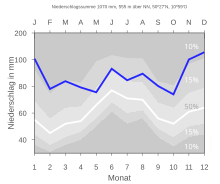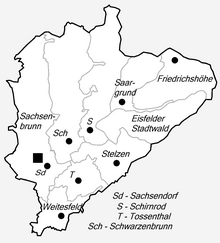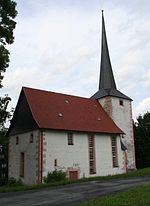Sachsenbrunn
|
Sachsenbrunn
City of ice field
|
|
|---|---|
| Coordinates: 50 ° 27 ′ 0 ″ N , 10 ° 58 ′ 0 ″ E | |
| Height : | 480 m |
| Area : | 33.86 km² |
| Residents : | 2050 (December 31, 2017) |
| Population density : | 61 inhabitants / km² |
| Incorporation : | 1st January 2019 |
| Postal code : | 98673 |
| Area code : | 03686 |
Sachsenbrunn is a district of Eisfeld in the Hildburghausen district in the Franconian south of the Free State of Thuringia .
geography
location
Sachsenbrunn is located on the upper reaches of the Werra , whose headwaters Werra and Saar join immediately above, in the former district of Schwarzenbrunn, at 491 m above sea level. The Sophienau settlement , which belongs to the former municipality of Sachsenbrunn, is located on the Werra headwaters, while the Saargrund district and Schirnrod district lie on the Saar.
Opposite are Stelzen , Tossenthal and Weitesfeld on the other side of the Rhine-Weser watershed on the upper reaches of the Itz , which drains to the Main and whose source is not far from Stelzen.
In terms of natural space , the headwaters belong to the Thuringian Slate Mountains and the actual districts to the Schalkau Plateau , with Stelzen and Schirnrod directly at the interface. The south-western slope of the 867 m high Bleßberg , the southern slope of the 839 m high Pechleite and the 789 m high Grendel with its 2 m higher foothills, the Frohnberg, are located in the district of the former municipality .
climate
The annual precipitation is 1071 mm and is therefore comparatively high and belongs to the upper tenth of the values recorded in Germany. Lower values are registered at 88% of the measuring stations of the German Weather Service . The driest month is October, the most precipitation falls in December. In December there is 1.7 times more rainfall than in October. Precipitation varies greatly. Higher seasonal fluctuations are registered at only 21% of the measuring stations.
Community structure
Districts of the municipality were:
- Friedrichshöhe
- Saargrund
- Sachsenbrunn
- Schirnrod
- Stilts
- Tossenthal
- Wide field
history
Sachsenbrunn was created on July 1, 1950 from the merger of Sachsendorf and Schwarzenbrunn. In 1967 the districts of Tossenthal and Weitesfeld were added. The unified church was formed on April 14, 1994 as part of the municipal area reform .
Sachsendorf was hit by the persecution of witches in 1583 . Lorenz Kriebel got into a witch trial . He was beaten with rods and had two fingers cut off.
On January 1, 2019, the independent municipality of Sachsenbrunn was incorporated into the city of Eisfeld. Since January 1, 2012, Eisfeld has been a fulfilling municipality for Sachsenbrunn.
religion
56% of the population are Protestant, 2% Catholic. There is an Evangelical Lutheran parish that has the parish church in Sachsenbrunn , the Marienkirche in stilts and a parish hall in Schirnrod ; the community belongs to the Hildburghausen-Eisfeld parish of the Evangelical Church in Central Germany . The few Catholics belong to the parish of St. Leopold (Hildburghausen) in the Meiningen deanery of the Erfurt diocese ; the next branch church is St. Elisabeth in Eisfeld .
politics
Municipal council
The municipal council in Sachsenbrunn last consisted of 14 council members:
- FWGS: 8 seats
- Active for Sachsenbrunn: 4 seats
- CDU : 2 seats
(As of: local elections on May 25, 2014)
coat of arms
Blazon : "In silver a raised, curved, rising green tip, which is covered with a golden linden tree, at the top in front a black mill wheel, at the top at the back a red rose with golden lugs."
Culture and sights
A prehistoric rampart is located on the heights of the castle hill.
The Itz rises north of the Stelzener Kirche . The latter was a pilgrimage church in the Middle Ages, which was built next to the source of the Itz, which is considered to be miraculous. The spring was considered a spring sanctuary.
Museums
The place has the only marble museum in Germany. It was created on the initiative of the stone sculptor Axel Trümper in a former water mill on the Werra. The small clay or stone balls served a wide variety of purposes, for example in powder mills or as toys. The rich display collection also provides information on the most common manufacturing techniques.
dialect
A Main Franconian local dialect is spoken in Sachsenbrunn, which is closely related to Itzgründischen , but is outside its dialect area due to a somewhat more modern local grammar .
Natural sights
The dance linden tree in Sachsenbrunn in the Sachsendorf district is one of the best preserved linden trees in Germany with a retracted dance podium supported by the linden tree itself.
Web links
Individual evidence
- ↑ Map services ( Memento of the original from December 19, 2012 in the Internet Archive ) Info: The archive link has been inserted automatically and has not yet been checked. Please check the original and archive link according to the instructions and then remove this notice. of the BfN
- ^ Main statute of the community Sachsenbrunn
- ↑ Ronald Füssel: The witch hunts in the Thuringian area. In: Publications of the working group for historical witchcraft and crime research in Northern Germany. Volume 2, Hamburg 2003, p. 235.
- ↑ census database
- ↑ Official election result of the 2014 local elections
- ↑ Michael Köhler : Pagan sanctuaries. Jenzig-Verlag 2007 ISBN 978-3-910141-85-8 , p. 187.
- ^ Rainer Graefe: Buildings from living trees. Guided dance and court linden trees . Geymüller, Publishing House for Architecture, Aachen [u. a.] 2014, ISBN 978-3-943164-08-4 , pp. 104 f .





